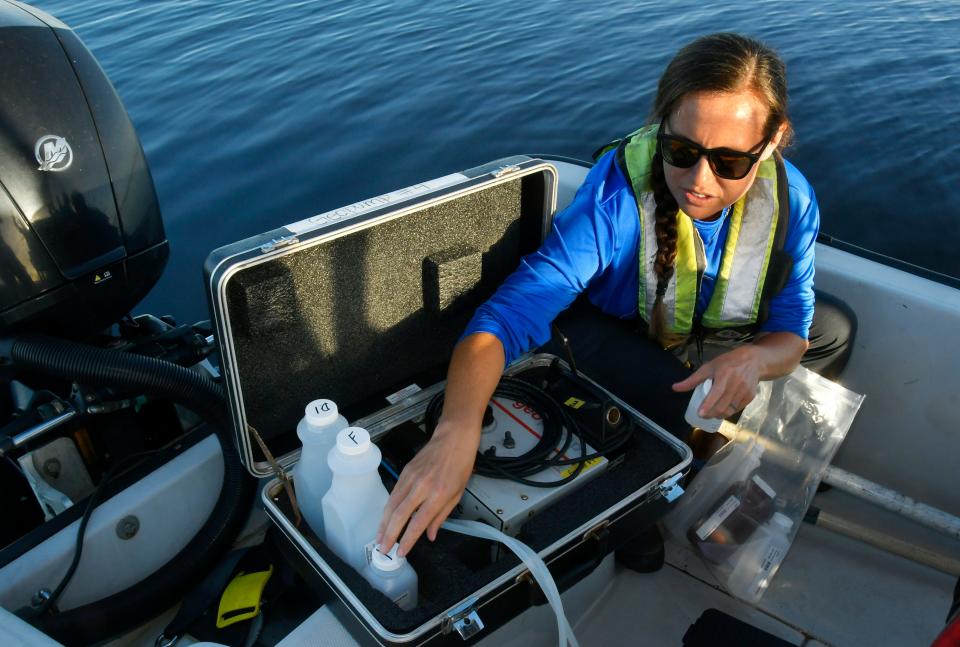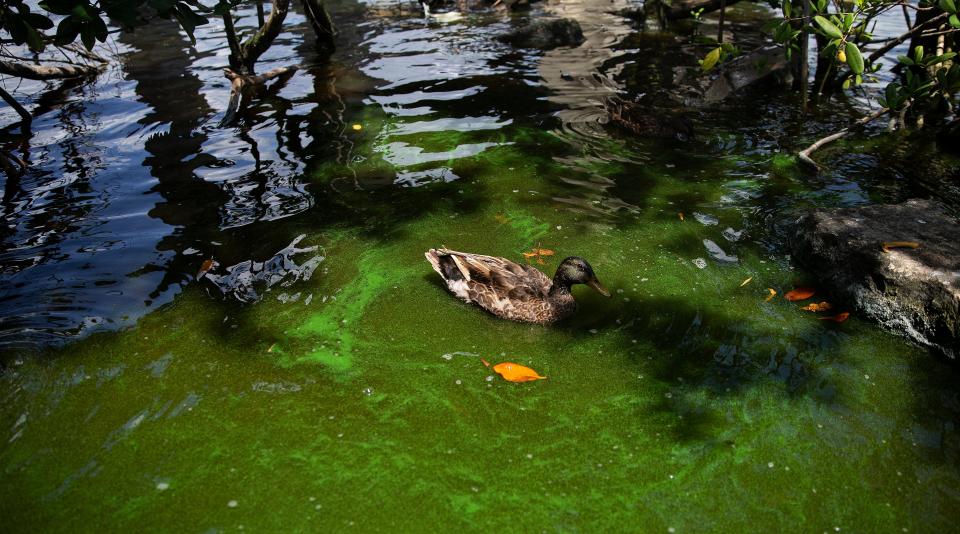CDC report: people and animals — dogs, cattle, and wildlife — are getting sick from algae
Time to yank back on that leash before your dog drinks what could be fatal.
A new federal report shows that we and animals we surround ourselves with — including dogs, cattle and most wildlife — are getting sicker and dying from exposure to toxic algae that forms in lakes and ponds. And the problem seems to be growing worse nationwide, especially during summer.

According to the Centers for Disease Control and Prevention's new study, 92% of animals that got ill from toxic algae blooms died. Those blooms peak in August, the study found, with 90% of the 368 harmful algae blooms occurring in lakes, reservoirs and other fresh waters.
CDC's study did not mention Florida, where the problem may be among the worst in the nation, given all the warm weather and surface waters. The study was based on voluntary reporting by public health agencies to CDC and their designated environmental health and/or animal-health partners.
Several Florida dogs have gotten sick or died from drinking water laden with toxic blue-green algae in recent years.

The cyanobacteria microcystis, also known as blue-green algae, has plagued Florida waterways for years, thriving on excess nitrogen and phosphorus from fertilizers, septic tanks and sewage spills.
In 2021, Bella, an 8-year-old boxer died after she ate toxin-laced detritus from a canal, marking her as possibly the first reported canine death in Palm Beach County from blue-green algae poisoning. Vomit from the 78-pound boxer had enough microcystin algae toxin in it to kill her, according to tests by Palatka-based Green Water Laboratories.
In 2018, six dogs got sick from blue-green algae in the St. Lucie River, one fatally.
What did CDC find?
Human illnesses from toxic blue-green algae happened predominately in June (33%). The most commonly reported symptoms were gastrointestinal, generalized (e.g., headache, fever), and dermatologic.
CDC found:
In 2021, there were 16 states that reported 117 human illnesses and 2,715 animal illnesses caused by excess algae.
Almost half (46%) of reported human illnesses caused by harmful algae were among people younger than 18 years old, suggesting children and teens may be at higher risk of illness than adults.
92% of the animals reported ill died, including a die-off of at least 2,000 bats from a single harmful algae bloom. This was the largest bat die-off linked to a harmful algae bloom ever reported to CDC.
2,328 animal illnesses (86%) happened in August, mostly involved wildlife, including the 2,000 bat deaths.
What is blue-green algae?
Blue-green algae are a type of bacteria that is common in Florida’s freshwater environments. A bloom occurs when rapid growth of algae leads to an accumulation of individual cells that discolor water and often produce floating mats that emit unpleasant odors.
Some environmental factors that contribute to blue-green algae blooms are sunny days, warm water temperatures, still water conditions and excess nutrients. Blooms can appear year-round but are more frequent in summer and fall. Many types of blue-green algae can produce toxins.
How is it harmful?
Blue-green algae blooms can impact human health and ecosystems, including fish and other aquatic animals.
For information on potential health effects of algae blooms, visit floridahealth.gov/environmental-health/aquatic-toxins.
Does it happen in East Central Florida?
Yes. Blue-green algal bloom conditions were observed or cyanobacteria was found to be the dominant species of algae in the sample. Not all blue-green algae contains toxins. However, adults, children and pets should avoid swimming in or drinking water from these waters while blue-green algal blooms are present.
In February, a blue-green algae bloom triggered health officials to warn visitors to Lake Washington not to swim, wade, boat, eat fish, or let pets sip the water.
Lake Washington is the main source of drinking water for more than 170,000 people served by the city of Melbourne's water system. But health officials have said in the past that when levels of the algae toxin are at trace levels there's no risk to water customers. The health department did not issue any notice regarding the city's drinking water.
On Wednesday, blue-green algae bloom conditions were observed in Blue Cypress Lake and a major nearby canal in Indian River County.
Where can I find current informationabout harmful algae?
Visit ProtectingFloridaTogether.gov. Protecting Florida Together is the state’s joint effort to provide statewide water quality information to prioritize environmental transparency and commitment to action.
What do I do if I see an algae bloom?
The Florida Department of Environmental Protection collects and analyzes algae bloom samples. To report a bloom to DEP, call the toll-free hotline at 855-305-3903 or report online.
To report fish kills, contact the Florida Fish and Wildlife Research Institute at 1-800-636-0511.
Report symptomsfrom exposure to a harmful algal bloom or any aquatic toxin to the Florida Poison Information Center, call 1-800-222-1222 to speak to a poison specialist immediately.
Contact your veterinarianif you believe your pet has become ill after consuming or having contact with blue-green algae contaminated water.
If you have other health questions or concerns about blue-green algae blooms, email the Florida Department of Health in Brevard at brevard.ehs@flhealth.gov or call 321-633-2100.
Jim Waymer is an environment reporter at FLORIDA TODAY. Contact Waymer at 321-261-5903 or jwaymer@floridatoday.com. Or find him on Twitter: @JWayEnviro or on Facebook: www.facebook.com/jim.waymer
This article originally appeared on Florida Today: CDC report: toxic algae is sickening us, our dogs, cattle, and wildlife

